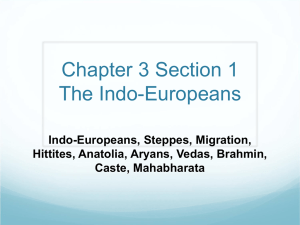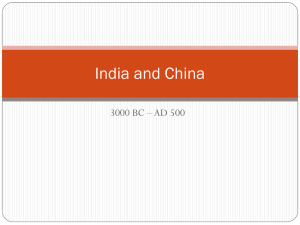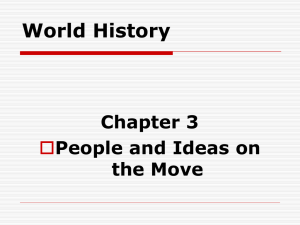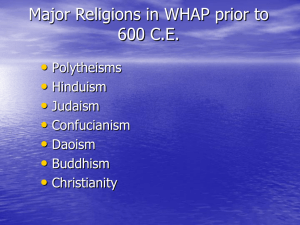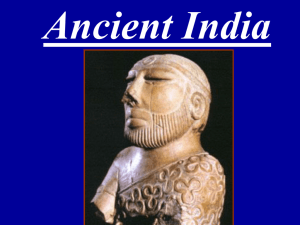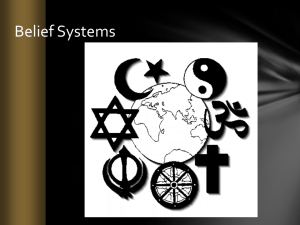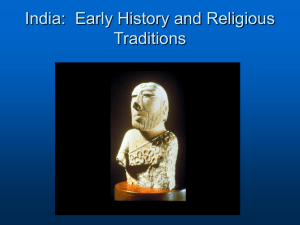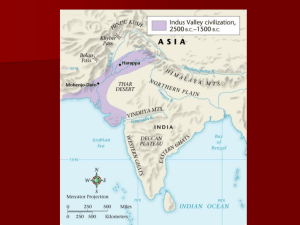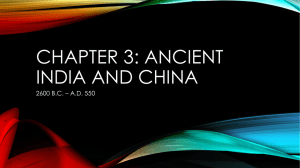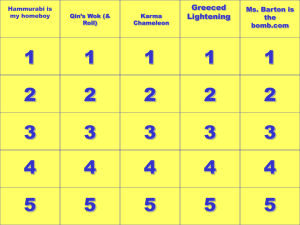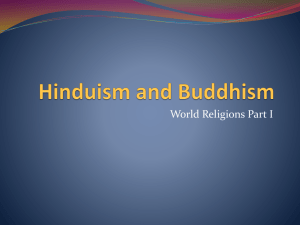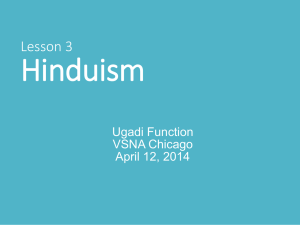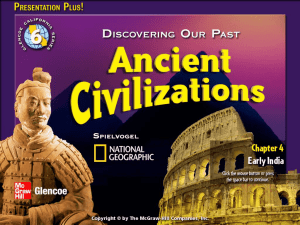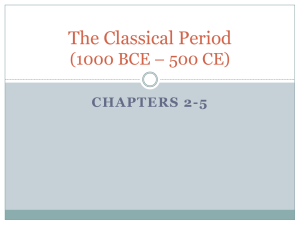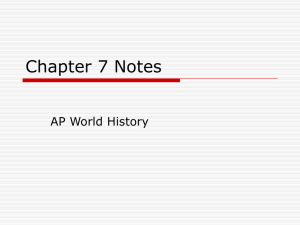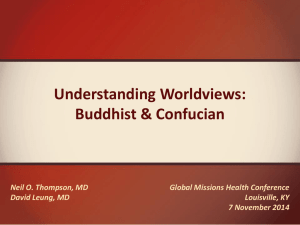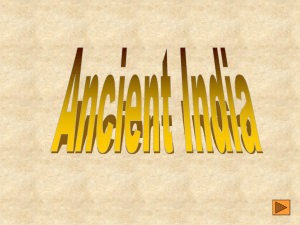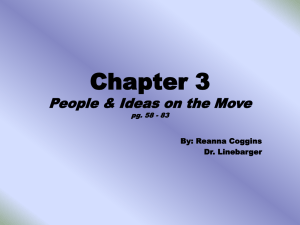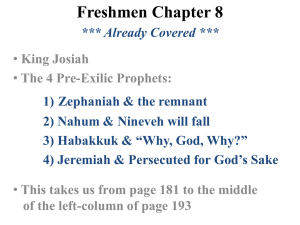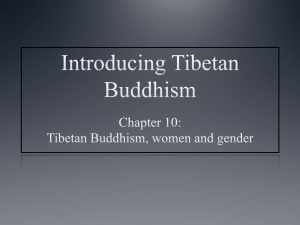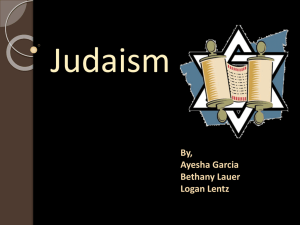People and Ideas on the Move, 2000 B.C.-250 B.C.
advertisement
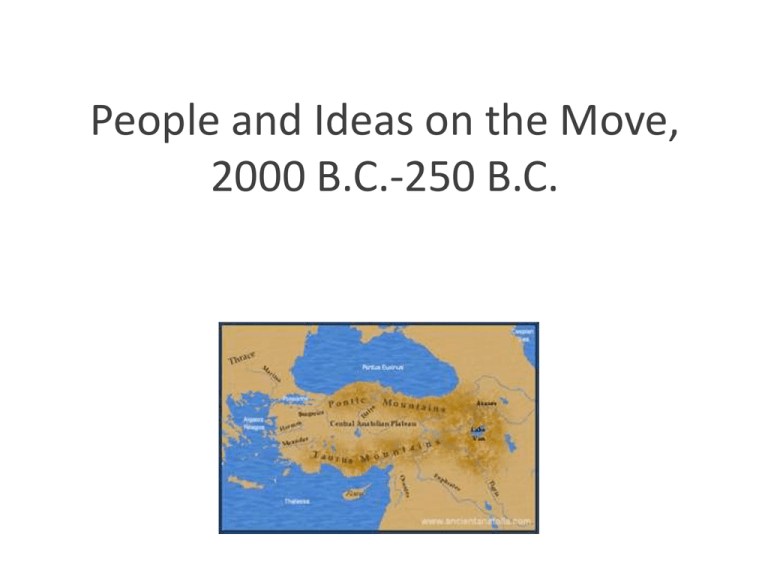
People and Ideas on the Move, 2000 B.C.-250 B.C. Chapter 3 Section 1 Chapter 3: Section 1 Vocabulary • Indo-Europeans: People who migrated from southern Russia to India, Europe and Southwest Asia, around 1500 BC • Steppes: Dry grass-covered plains • Migration: To move from one place to another • Hittites: Indo-Europeans who settled in Anatolia around 2000 BC • Anatolia: Southwestern Asian peninsula (Turkey) aka, Asia Minor • Aryans: Indo-Europeans who migrated to Indian subcontinent • Vedas: Four sacred writings by the Aryans • Brahmin: Priest in Aryan society • Caste: Aryan social class system; ridged, (Priests, warriors, peasants/traders and non-Aryan workers) • Mahabharata: Indian epic poem, reflecting the struggles of the Aryan migration south to India Indo-Europeans Migrate • Indo-Europeans: Nomadic people from the “Steppes” or dry grass lands that stretch north of the Caucus Mts. • Herders: Sheep, Cattle, Goats • Indo-Europeans Language: Basis of other Major Languages (PG 61) • Unexplained Migration? • Indo-Europeans migrated between 1700-1200 B.C. Caucasus Mts. The Hittite Empire • 200 B.C. Hittites controlled the land called Anatolia • 450 year rule • Anatolia is “Turkey” surrounded by the Black Sea and the Mediterranean Sea • Geography: high, rocky plateau, rich in timber and agriculture. Mts full of natural minerals (resources) • Controlled Mesopotamia • Cultural Diffusion: • Hittites adopted the Babylonian Language for trading. • Borrowed ideas about literature, arts, politics, • Chariots and Iron Technology • Superior Chariot Technology • Iron Weapons. Iron stronger than Bronze • Decline of Hittite Empire • 1190 B.C. due to tribes from the North and South attacking. HITTITE EMPIRE MAP Aryans Migrate to Indus River Valley Aryans Transform India • Aryans: Homeland between the Caspian and Aral Seas • Map: Next Slide • Migrated to the Indus River Valley • Almost no archaeological Record • Vedas: 4 Collections of prayers, Magical Spells, Instructions for performing Rituals • Rig Veda (MVP) contains 1,028 hymns to Aryan Gods • Vedas past on by story telling Asia: Caspian and Aral Seas A Caste System Develops • Aryan Nobles called Native Indians “Dasas” or Dark • Differences between Aryans and Indians – – – – Aryans were… Taller Lighter skin Spoke a different Languages – No Writing System – Counted wealth in cows – “Dasas” lived in towns/communities protected by walls • The Aryan Caste System Pg 64 – Brahmins (Mouth): Priests – Kshatriyas (Arms): Rulers and Warriors – Vaishyas (Legs): Peasants and traders) – Shudras (Feet): Laborers – “Untouchables: Butchers, gravediggers, garbage collectors “Physical Labor” • Hundreds of subdivisions Caste System Aryan Kingdom Arise • Moved deeper into India: Ganges and Yamuna River Valleys • Kingdom of Magadha • Unified (took over) all of India • Mahabharata: Reflects the struggles that took place in India as the Aryans moved south • Cultural Diffusions: – Krishna: Semi-divine hero of the Mahabharata is described as being dark faced. (Dasa Influence) Main Idea Questions: Separate Piece of Paper • What were some of the technological achievements of the Hittites? • What were some of the borrowings of Hittites? • Where did the Aryan come from when they arrived in India? Hinduism and Buddhism Develop Chapter 3:2 Chapter Vocabulary • Reincarnation: (rebirth) an individual soul or spirit is born again and again until “Moksha” is met • Karma: good or bad deeds that follow from one reincarnation to another. Influences certain things in life (what caste one is born into, ones state of health, wealth, or poverty, etc.) • Jainism: Founded by Mahavira. Believes that everything in the universe has a soul and therefore nothing should be harmed (nonviolent) • Siddhartha Gautama: Founder of Buddhism (The Buddha) • Enlightenment: In Buddhism, a state of perfect wisdom in which one understands basic truths about the universe • Nirvana: In Buddhism, the release from pain and suffering achieved after enlightenment India Hinduism Evolves Over Centuries • Collection of Religious beliefs • Cannot be traced back to a “single” founder with a single set of ideas • Upanishads: Books that show Hindu teachings – Moksha: A state of perfect understanding of all things – Atman: the individual soul of living being – Brahman: the World soul that unites all “Atmans” Hinduism • When a person reaches “Moksha” a person is released from life in this world. (multiple lifetimes to happen) • Reincarnation • Karma effects what caste you are born into Hinduism Hinduism Changes and Develops Hinduism and Society • Hinduism: 3 Main Gods – Brahma: The Creator – Vishnu: The Protector – Shiva: The Destroyer • Hindus are free to choose the deity they worship or none at all Karma and Reincarnation strengthened “Caste System” Bad Deeds: “Born as a women, or untouchable” Caste determines what a person can or cannot eat New Religions Arise in India Jainism • Founded by Mahavira: 599 B.C.- 527 B.C. • “Everything in the Universe has a soul and so should not be harmed.” • Wears masks over face to no breath in insects • Jobs that will not harm anyone: merchants/traders Buddhism • Siddhartha Gautama • Prophecy: A Great man – Stay home: World Ruler – Leave Home: Spiritual Ruler • Age 29 left the palace 4 times – – – – Old man Sick man Dead man Religious Man (At Peace) Buddhism • After “Trip” outside the city Siddhartha G. decided to spend his life looking for a religious/spiritual meaning to life (Only refuge from suffering!!) • Wandered 6 years Seeking Enlightenment • Ate only 6 grains of rice a day • Meditated 49 days under a fig tree – Eventually achieved Enlightenment: Discovered the cause of suffering in the world Buddhism: Origins and Beliefs “The First Sermon” The Four Noble Truths First Noble Truth Life is filled with suffering and sorrow Second Noble Truth The cause of all suffering is peoples selfish desire for the temporary pleasures of this world Third Noble Truth The way to end all suffering is to end all desires Fourth Noble Truth The way to overcome such desires and attain enlightenment is to follow the Eightfold Path, which is called the “Middle Way” between desires and self-denial Buddhism: Origins and Beliefs • Eightfold Path: A guided for ones behavior • Those seeking enlightenment, you must master one step at a time! • By following the Eightfold Path anyone can reach: Nirvana • Nirvana: The release from selfishness and pain Buddhism: Origins and Beliefs • Belief in Reincarnation • The Cycle of the World: The World is created and destroyed Multiple Times. • Rejected the many gods of Hinduism • Rejected the Caste System • Goals For Hinduism/Buddhism: “Moksha” and “Nirvana” • Achieve a PERFECT state of understanding and a break from the chain of reincarnations Buddhism Religious Community Buddhism and Society • Religious followers of Buddhism are called the Sangha • Three Jewels of Buddhism • Rejected Caste: Many followers were lower class • Monks/Nuns: Life of poverty, nonviolent, never marry • Missionaries: Depend on the kindness of people to survive – Buddha – Dharma – Sangha Buddhism Buddhism in India • Missionaries spread along trade routes – Sri Lanka – China • Never took a strong foothold in India where it was born!!! • Buddhist make pilgrimages to India Trade and the Spread of Buddhism • • • • Sri Lanka Burma Thailand Island of Sumatra (Island in Indonesia) • China • Korea • Japan Hinduism and Buddhism Did you learn anything??? • What are the Four Noble Truths of Buddhism? • How has Hinduism influence the social structure in India? • How did Buddhism Spread? • How are the Vedas and the Upanishads similar? Seafaring Traders Chapter 3:3 Vocabulary Terms 1. Minoans: A seafaring and trading people that lived on the island of Crete from about 2,000 to 1400 B.C. 2. Aegean Sea: The sea that separates modern day Turkey and Greece 3. Knossos: Minoan capital City 4. King Minos: King of the the Minoans, city of Knossos (Crete) Owned a Minotaur. 5. Phoenicians: A seafaring people of Southwest Asia, who around 1100 B.C. began to trade and established colonies throughout the Mediterranean region Mr. Erickson or a Minotaur Minoans Trade in the Mediterranean • Minoans lived in the eastern portion of the Mediterranean from about 2,000-1400 B.C. • Cultural Diffusion: Traded pottery, swords, precious metals, Architecture, burial customs and religious customs • Major influence on Greece • Island of Crete was a “stepping stone” Unearthing a Brilliant Civilization • Knossos: Minoan Capital City on the Island of Crete • Peaceful because it had no fortifications • King Minos: Pet Minotaur: Labyrinth (maze) • Wall Paintings, pottery, etc. show that the Minoans were a graceful, athletic people who loved nature and beautiful objects. • Sports: Boxing, Wrestling, and Bull Jumping Minoan Civilization • Women had role in religious ceremonies • Women had a “Higher Rank” that in other societies • Sacrificed bulls, animals and humans to please the gods. • Mysterious End: Ended in 1200 B.C. • No idea • Natural Disaster or invasions Minoan Decline Possible Causes Example Natural Disaster •Possible Earthquake 1700 BC •Earthquake 1470 BC •Volcanic Eruption on neighboring island 1470BC •Tidal wave 1470 BC Overpopulation Non given Overrun by invaders From Greece, about 1200 BC Phoenicians: Spread Ideas Phoenicians Spread Trade and Civilization • Mediterranean Traders located on the Far Eastern end of the Sea (Lebanon) • Never a Country: City States • 3 Major Cities: Byblos, Tyre, Sidon • Excellent Ship Builders and Seafarers • Possible sailed to Britain 2,000 yrs before everyone else • Traded: Wine, weapons, precious metals, ivory • Phoenicians were: great superb craftsman “Wood, metal glass and ivory” • 60,000 Snails needed for a pound of Dye Murex Dye Phoenician’s Greatest Gift: The Alphabet • Greatest Legacy: The Alphabet • Needed a way to “quickly” record transitions • Used symbols to represent sounds • One sign was used for one sound • Cultural Diffusion: Writings spread all throughout their trading routes • Greeks adopted the Phoenician alphabet and changed the from of some of the letters Main Idea Questions: PG 76 1.What did the excavations at Knossos reveal about Minoan culture? 2.Where did the Phoenicians settle and trade? 3.Why did the Phoenicians develop a writing system? The Origins of Judaism Chapter 3:4 Chapter Vocabulary: 3:4 • Palestine: Eastern end of the Mediterranean Sea • Canaan: Ancient homeland of the Hebrews (Jews) • Torah: The First Five books of the Hebrew Bible which states Hebrew Traditions and stories. Christians consider this the “Old Testament” • Abraham: “Father of the Jews” • Monotheism: A belief in a single god • Covenant: The promise between God and the founder of the Hebrew People. (Promise) • Moses: The man who lead the Hebrews out of slavery from Egypt • Israel: The new name of the Kingdom of the Jews after Saul, David and Solomon united the Jews • Judah: Name of the “Southern” portion of the Jewish Kingdom • Tribute: Peace money paid by a weaker power to a stronger power Search for a Promised Land • Palestine and Canaan • Hebrews settled in Canaan • Located at a Crossroads • Egypt to the West • Assyria and Babylonia to the East Birth of Judaism • Torah: First five books of the Hebrew Bible (Old Testament) • Abraham: Lived in Ur – God chose Abraham to be the “Father of the Jews” – Covenant: Promise between Abraham/Descendants and God • Monotheistic: Believe in One Ultimate God • God = Yahweh • “God watches over the Jews bc. of Abrahams promise Moses and the Exodus • Jews migrated to Egypt to escape a drought • 1st Egyptians were nice • Later Egyptians felt threatened and “enslaved them” • Moses lead the Jews out of Egypt • New Covenant •God spoke to Moses in Sinai Desert •Rules for new society of Jews • The Ten Commandments Moses Wonders the Desert • Moses and the Hebrews/Jews wonder for 40 years • Returned to “Canaan” • Shifted from Nomads to City Dwellers • 12 Tribes of Jews – United for battle – Different rulers “Judges” The Kingdom of Israel • Saul, David, Solomon Establish a Kingdom • Israel: Named after one of the 12 tribes • 100 years of Great Power • 200 years total • Traders: Located close to the Med. Sea • Solomon's Temple – Bronze Pillars – Stone walls (outside) – Gold walls (Inside) • Held the Ark of the Covenant • High Taxes to pay for build • Caused divide in Northern Israel – Tribe of Judah Broke off – Where is the Ark Video: Jerusalem The Babylonian Captivity • • • • • • Declined Tributes: Paid to Assyria (Both Judah and Israel) Diaspora of Jews Assyrians eventually took over Israel Judah taken over by Babylonians 150 later Persian King Cyrus conquered Babylonians and allowed Jews to return to Jerusalem • Taken over by: Persians, Greeks, Romans etc. Diaspora of Jews Discussion Questions • Where did Abraham and his Family originally come from? • What were some of the achievements of Solomon? • What was the Babylonian Captivity? Three Major Religions Hinduism Buddhism Judaism Number of Gods Many Gods; Brahma, Vishnu, Shiva Originally, no Gods One God: Yahweh Holy Books Vedas: Upanishads, Mahabharata, others Books based on the teachings of Buddha Tripataka The Torah and other books of the Hebrew Bible Moral Law Karma Eightfold Path/Karma Ten Commandments Leaders Brahmins Monks Priests, Judges, Kings and Prophets Final Goal Moksha Enlightenment, Nirvana A moral life through obedience to God’s Law
